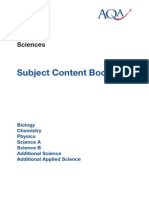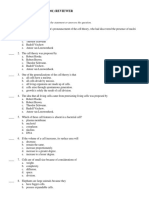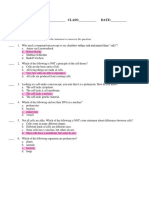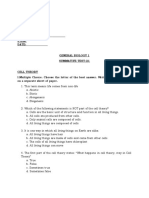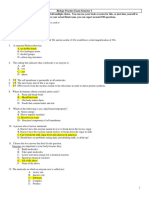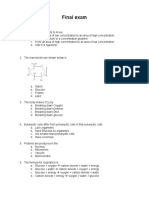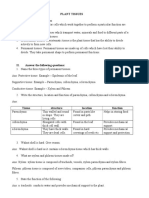Chapter 4 Cell Structure Study Guide
Uploaded by
VincentBauzaChapter 4 Cell Structure Study Guide
Uploaded by
VincentBauza7/22/2014
Chapter 4 Cell Structure study guide
Name: vincent
Score: 0 / 99 points (0%)
[23 open-ended questions not graded]
Chapter 4 Cell Structure study guide
Modified True/False
Indicate whether the statement is true or false. If false, change the identified word or phrase to make the
statement true.
1. Robert Hooke first observed cells by looking at a thin slice of cork under a microscope.
_________________________
RESPONSE:
ANSWER: T
POINTS:
0/1
2. Mathias Schleiden concluded that cells make up every part of a plant.
_________________________
RESPONSE:
ANSWER: T
POINTS:
0/1
3. Differences in the colors of cells enable different cells to perform different functions.
_________________________
RESPONSE:
ANSWER: F,shapes
POINTS:
0/1
4. All cells have a cell wall that surrounds them. _________________________
RESPONSE:
ANSWER: F,membrane
POINTS:
0/1
5. All multicellular organisms are made up of prokaryotic cells. _________________________
RESPONSE:
ANSWER: F,eukaryotic
POINTS:
0/1
6. The cells of animals are prokaryotic. _________________________
RESPONSE:
http://www.biologyjunction.com/chapter_4_cell_structure_studyguide.htm
1/21
7/22/2014
Chapter 4 Cell Structure study guide
ANSWER:
POINTS:
F,eukaryotic
0/1
7. The cytoskeleton is a web of protein fibers in eukaryotic cells. _________________________
RESPONSE:
ANSWER: T
POINTS:
0/1
8. Substances made in the nucleus, such as RNA messages, move into the nucleolus by passing
through nuclear pores. _________________________
RESPONSE:
ANSWER: F,cytoplasm
POINTS:
0/1
9. Flattened, membrane-bound sacs that package and distribute proteins are called the Golgi
apparatus. _________________________
RESPONSE:
ANSWER: T
POINTS:
0/1
10. Ribosomes attached to the smooth ER make proteins. _________________________
RESPONSE:
ANSWER: F,rough
POINTS:
0/1
11. Lysosomes contain specific enzymes that break down large molecules, such as food particles.
_________________________
RESPONSE:
ANSWER: T
POINTS:
0/1
12. Ribosomes are the sites of ATP production in animals. _________________________
RESPONSE:
ANSWER: F,Mitochondria
POINTS:
0/1
13. Most of a cells ATP is produced in the cells mitochondria. _________________________
RESPONSE:
ANSWER: T
POINTS:
0/1
http://www.biologyjunction.com/chapter_4_cell_structure_studyguide.htm
2/21
7/22/2014
Chapter 4 Cell Structure study guide
14. A typical animal cell contains one or more chloroplasts. _________________________
RESPONSE:
ANSWER: F,plant
POINTS:
0/1
15. A chloroplast is an organelle that uses light energy to make sugar from carbon dioxide and
water. _________________________
RESPONSE:
ANSWER: T
POINTS:
0/1
16. Prokaryotes are always multicellular organisms. _________________________
RESPONSE:
ANSWER: F,unicellular
POINTS:
0/1
17. Many prokaryotes have flagella that allow them to attach to surfaces.
_________________________
RESPONSE:
ANSWER: F,pili
POINTS:
0/1
18. A tissue is a distinct group of cells that have similar structures and functions.
_________________________
RESPONSE:
ANSWER: T
POINTS:
0/1
19. A leaf is made up of different tissues that work together. _________________________
RESPONSE:
ANSWER: T
POINTS:
0/1
20. In multicellular organisms, a single cell must carry out all of the organisms activities.
_________________________
RESPONSE:
ANSWER: F,unicellular
POINTS:
0/1
21. A unicellular organism is composed of many individual, permanently associated cells that
http://www.biologyjunction.com/chapter_4_cell_structure_studyguide.htm
3/21
7/22/2014
Chapter 4 Cell Structure study guide
coordinate their activities. _________________________
RESPONSE:
ANSWER: F,multicellular
POINTS:
0/1
22. Colonial organisms are unicellular organisms that can live as a connected group or survive when
separated. _________________________
RESPONSE:
ANSWER: T
POINTS:
0/1
23. Some protists and most fungi have a multicellular body. _________________________
RESPONSE:
ANSWER: T
POINTS:
0/1
24. Most multicellular organisms begin as a single cell. _________________________
RESPONSE:
ANSWER: T
POINTS:
0/1
Multiple Choice
Identify the choice that best completes the statement or answers the question.
25. Which of the following led to the discovery of cells?
a. electricity
c. microscopes
b. computers
d. calculators
ANSWER: C
POINTS:
0/1
FEEDBACK:
26. Which of the following is part of the cell theory?
a. All living things are made of one cell.
b. Cells are the basic units of structure and function in organisms.
c. Most cells arise from existing cells.
d. Cells are nonliving units that make up organisms.
ANSWER: B
POINTS:
0/1
FEEDBACK:
http://www.biologyjunction.com/chapter_4_cell_structure_studyguide.htm
4/21
7/22/2014
Chapter 4 Cell Structure study guide
27. When the volume of a cell increases, its surface area
a. increases at the same rate.
c. increases at a faster rate.
b. remains the same.
d. increases at a slower rate.
ANSWER: D
POINTS:
0/1
FEEDBACK:
28. Surface area is an important factor in limiting cell growth because
a. the cell can burst if the membrane becomes too large.
b. materials cannot enter the cell if it is too large.
c. the cell may become too large to take in enough food and to remove enough wastes.
d. waste products cannot leave the cell if it is too small.
ANSWER: C
POINTS:
0/1
FEEDBACK:
29. The size to which cells can grow is limited by their
a. location.
c. function.
b. structure.
d. surface area-to-volume ratio.
ANSWER: D
POINTS:
0/1
FEEDBACK:
30. As cell size increases, the surface area-to-volume ratio
a. decreases.
c. increases then decreases.
b. increases.
d. remains the same.
ANSWER: A
POINTS:
0/1
FEEDBACK:
31. To function most efficiently, a cells size must be
a. large.
c. small.
b. medium.
d. any size.
ANSWER: C
POINTS:
0/1
FEEDBACK:
32. Which of the following shapes would allow a cell to have the greatest surface area-to-volume
ratio?
a. sphere
c. egg-shaped
b. cube
d. broad and flat
http://www.biologyjunction.com/chapter_4_cell_structure_studyguide.htm
5/21
7/22/2014
Chapter 4 Cell Structure study guide
ANSWER: D
POINTS:
0/1
FEEDBACK:
33. A cube with a side length of 6 mm has a surface area-to-volume ratio of
a. 1:1.
c. 3:1.
b. 2:1.
d. 6:1.
ANSWER: A
POINTS:
0/1
FEEDBACK:
34. One difference between prokaryotes and eukaryotes is that prokaryotes do not have
a. DNA.
c. cytoplasm.
b. a cell membrane.
d. a nucleus.
ANSWER: D
POINTS:
0/1
FEEDBACK:
35. Which cells have a cell membrane, cytoplasm, ribosomes, and DNA?
a. only animal cells
c. only eukaryotic cells
b. only prokaryotic cells
d. all cells
ANSWER: D
POINTS:
0/1
FEEDBACK:
36. The genetic material that provides instructions for making proteins is
a. DNA.
c. cytoplasm.
b. cytosol.
d. a ribosome.
ANSWER: A
POINTS:
0/1
FEEDBACK:
37. A structure within a eukaryotic cell that carries out specific activities inside the cell is called a(n)
a. organelle.
c. nucleus.
b. cytoplasm.
d. membrane.
ANSWER: A
POINTS:
0/1
FEEDBACK:
38. Which of the following statements about prokaryotes is correct?
a. They have a nucleus.
b. Their evolution preceded that of eukaryotes.
http://www.biologyjunction.com/chapter_4_cell_structure_studyguide.htm
6/21
7/22/2014
Chapter 4 Cell Structure study guide
c. The organelles in their cytoplasm are surrounded by membranes.
d. They are multicellular organisms.
ANSWER: B
POINTS:
0/1
FEEDBACK:
39. Only eukaryotic cells have
a. DNA.
b. membrane-bound organelles.
c. ribosomes.
d. cytoplasm.
ANSWER: B
POINTS:
0/1
FEEDBACK:
40. Refer to the illustration above. Which structure acts as a boundary between the outside
environment and the inside of the cell?
a. structure 1
c. structure 3
b. structure 2
d. structure 4
ANSWER: D
POINTS:
0/1
FEEDBACK:
41. Refer to the illustration above. Which structure immediately identifies this cell as a eukaryote?
a. structure 1
c. structure 3
b. structure 2
d. structure 4
ANSWER: B
POINTS:
0/1
FEEDBACK:
42. Refer to the illustration above. In eukaryotic cells, DNA is found in
a. structure 1.
c. structure 3.
http://www.biologyjunction.com/chapter_4_cell_structure_studyguide.htm
7/21
7/22/2014
Chapter 4 Cell Structure study guide
b. structure 2.
d. structure 5.
ANSWER: B
POINTS:
0/1
FEEDBACK:
43. Refer to the illustration above. Structure 2 is
a. rough endoplasmic reticulum.
c. a mitochondrion.
b. a Golgi apparatus.
d. the nucleus.
ANSWER: D
POINTS:
0/1
FEEDBACK:
44. Refer to the illustration above. Which structure produces vesicles filled with proteins?
a. structure 1
c. structure 4
b. structure 2
d. structure 5
ANSWER: A
POINTS:
0/1
FEEDBACK:
45. Refer to the illustration above. Structure 5 is
a. part of the endoplasmic reticulum.
c. a mitochondrion.
b. a Golgi apparatus.
d. the nucleus.
ANSWER: B
POINTS:
0/1
FEEDBACK:
46. Refer to the illustration above. The cell uses structure 3 to
a. transport material from one part of the cell to another.
b. package proteins so they can be stored by the cell.
c. use light energy to make sugar.
d. use energy from organic compounds to make ATP.
ANSWER: D
POINTS:
0/1
FEEDBACK:
47. Refer to the illustration above. The cell shown is probably an animal cell because it
a. has mitochondria.
c. has a cell membrane.
b. does not have a cell wall.
d. does not have a nucleus.
ANSWER: B
POINTS:
0/1
FEEDBACK:
http://www.biologyjunction.com/chapter_4_cell_structure_studyguide.htm
8/21
7/22/2014
Chapter 4 Cell Structure study guide
48. Microfilaments, microtubules, and intermediate fibers are three kinds of cytoskeleton
a. protein fibers.
c. organelles.
b. membranes.
d. DNA.
ANSWER: A
POINTS:
0/1
FEEDBACK:
49. What kind of cytoskeleton fibers could help a cell change shape to fit into a space?
a. microfilaments
c. intermediate fibers
b. microtubules
d. tubulin fibers
ANSWER: A
POINTS:
0/1
FEEDBACK:
50. Which of the following is true of both DNA and some proteins?
a. made in nucleus
b. made in ribosomes
c. must be kept separate from cytoplasm
d. must be kept separate from nucleus
ANSWER: C
POINTS:
0/1
FEEDBACK:
51. cell : cell membrane ::
a. nucleus : DNA
b. nucleus : nuclear envelope
c. organelle : cell
d. cell : DNA
ANSWER: B
POINTS:
0/1
FEEDBACK:
52. The double membrane surrounding the nucleus is called the
a. nucleolus.
c. ribosome.
b. nuclear wall.
d. nuclear envelope.
ANSWER: D
POINTS:
0/1
FEEDBACK:
53. In a cell, proteins are made on the
a. mitochondria.
b. ribosomes.
ANSWER:
c. nucleus.
d. cell membrane.
http://www.biologyjunction.com/chapter_4_cell_structure_studyguide.htm
9/21
7/22/2014
Chapter 4 Cell Structure study guide
POINTS:
0/1
FEEDBACK:
54. Where are bound ribosomes located?
a. suspended in the cytosol
b. inside the nucleus
c. attached to membranes of another organelle
d. outside the cell membrane
ANSWER: C
POINTS:
0/1
FEEDBACK:
55. The organelle that moves proteins and other substances through the cell is the
a. endoplasmic reticulum.
c. Golgi apparatus.
b. mitochondrion.
d. cytoplasm.
ANSWER: A
POINTS:
0/1
FEEDBACK:
56. The organelle that modifies, sorts, and packages proteins is the
a. endoplasmic reticulum.
c. lysosome.
b. ribosome.
d. Golgi apparatus.
ANSWER: D
POINTS:
0/1
FEEDBACK:
57. Refer to the illustration above. The structures labeled 4 are
a. vesicles.
c. ribosomes.
b. lysosomes.
d. chloroplasts.
http://www.biologyjunction.com/chapter_4_cell_structure_studyguide.htm
10/21
7/22/2014
Chapter 4 Cell Structure study guide
ANSWER: C
POINTS:
0/1
FEEDBACK:
58. Refer to the illustration above. Which structure packages proteins for distribution?
a. structure 1
c. structure 3
b. structure 2
d. structure 4
ANSWER: B
POINTS:
0/1
FEEDBACK:
59. Refer to the illustration above. Structure 3 is a(n)
a. mitochondrion.
c. ribosome.
b. endoplasmic reticulum.
d. vesicle.
ANSWER: D
POINTS:
0/1
FEEDBACK:
60. Plant cells have a large membrane-bound compartment in which water, waste products, and
nutrients can be stored. This compartment is called the
a. mitochondrion.
c. Golgi apparatus.
b. chloroplast.
d. central vacuole.
ANSWER: D
POINTS:
0/1
FEEDBACK:
61. A cell that requires a lot of energy might contain large numbers of
a. chromosomes.
c. mitochondria.
b. vacuoles.
d. lysosomes.
ANSWER: C
POINTS:
0/1
FEEDBACK:
62. The organelles associated with plant photosynthesis are the
a. mitochondria.
c. Golgi apparatus.
b. chloroplasts.
d. vacuoles.
ANSWER: B
POINTS:
0/1
FEEDBACK:
63. sunlight : chloroplasts ::
a. chloroplasts : lysosomes
http://www.biologyjunction.com/chapter_4_cell_structure_studyguide.htm
c. organic compounds : ribosomes
11/21
7/22/2014
Chapter 4 Cell Structure study guide
b. organic compounds : mitochondria
d. ATP : vesicles
ANSWER: B
POINTS:
0/1
FEEDBACK:
64. What do chloroplasts and mitochondria have in common?
a. absorption of light energy
c. production of ATP
b. presence in all cells
d. digestion of cell wastes
ANSWER: C
POINTS:
0/1
FEEDBACK:
65. All the following are found in both plant and animal cells, except
a. a cell wall.
c. mitochondria.
b. a cell membrane.
d. endoplasmic reticulum.
ANSWER: A
POINTS:
0/1
FEEDBACK:
66. Short, thick outgrowths that allow prokaryotes to attach to surfaces or each other are called
a. flagella.
c. microfilaments.
b. microtubules.
d. pili.
ANSWER: D
POINTS:
0/1
FEEDBACK:
67. Which of the following is an example of a prokaryotic cell?
a. chloroplast
c. bacterium
b. fungus
d. muscle cell
ANSWER: C
POINTS:
0/1
FEEDBACK:
68. Which of the following pairs contains unrelated items?
a. eukaryote-plant
c. cell wall-animal cell
b. ribosome-protein
d. mitochondria-ATP
ANSWER: C
POINTS:
0/1
FEEDBACK:
69. What level of organization is the small intestine?
http://www.biologyjunction.com/chapter_4_cell_structure_studyguide.htm
12/21
7/22/2014
Chapter 4 Cell Structure study guide
a. cell
b. tissue
c. organ
d. organ system
ANSWER: C
POINTS:
0/1
FEEDBACK:
70. Which of the following statements about colonial organisms is correct?
a. They are multicellular.
b. Their cell activities are integrated.
c. They are a collection of different kinds of cells.
d. They can survive when separated.
ANSWER: D
POINTS:
0/1
FEEDBACK:
Completion
Complete each statement.
71. All cells arise from ____________________.
RESPONSE:
ANSWER: existing cells
POINTS:
0/1
72. The basic unit of structure and function in an organism is the ____________________.
RESPONSE:
ANSWER: cell
POINTS:
0/1
73. The statement that cells arise only from existing cells is part of the ____________________.
RESPONSE:
ANSWER: cell theory
POINTS:
0/1
74. As a cells size decreases, its surface area-to-volume ratio ____________________.
RESPONSE:
ANSWER: increases
POINTS:
0/1
75. The surface area-to-volume ratio limits a cells ____________________.
http://www.biologyjunction.com/chapter_4_cell_structure_studyguide.htm
13/21
7/22/2014
Chapter 4 Cell Structure study guide
RESPONSE:
ANSWER: size
POINTS:
0/1
76. Eukaryotic cells contain specialized structures called ____________________.
RESPONSE:
ANSWER: organelles
POINTS:
0/1
77. A cell with a nucleus is a(n) ____________________ cell.
RESPONSE:
ANSWER: eukaryotic
POINTS:
0/1
78. Scientists think that ____________________ cells evolved about 1.5 billion years ago.
RESPONSE:
ANSWER: eukaryotic
POINTS:
0/1
79. All substances that enter or leave a cell must cross the cell ____________________.
RESPONSE:
ANSWER: membrane
POINTS:
0/1
80. The ____________________ houses a cells DNA, which contains genetic material.
RESPONSE:
ANSWER: nucleus
POINTS:
0/1
81. The organelles where protein synthesis occurs in a cell are called ____________________.
RESPONSE:
ANSWER: ribosomes
POINTS:
0/1
82. Prokaryotic cells have a cell ____________________ that surrounds the cell membrane.
RESPONSE:
ANSWER: wall
POINTS:
0/1
83. Some prokaryotic cells have a ____________________ that surrounds the cell wall.
http://www.biologyjunction.com/chapter_4_cell_structure_studyguide.htm
14/21
7/22/2014
Chapter 4 Cell Structure study guide
RESPONSE:
ANSWER: capsule
POINTS:
0/1
84. ____________________ cells have a system of internal membranes that divides the cytoplasm
into compartments.
RESPONSE:
ANSWER: Eukaryotic
POINTS:
0/1
85. The web of protein fibers that supports the shape of the cell is called the
____________________.
RESPONSE:
ANSWER: cytoskeleton
POINTS:
0/1
86. The cytoskeletons network of ____________________ fibers anchors cell organelles.
RESPONSE:
ANSWER: protein
POINTS:
0/1
87. A ribosome is made of ____________________ and many proteins.
RESPONSE:
ANSWER: RNA
POINTS:
0/1
88. DNA instructions are copied as ____________________ messages.
RESPONSE:
ANSWER: RNA
POINTS:
0/1
89. Ribosomes use RNA messages to assemble ____________________.
RESPONSE:
ANSWER: proteins
POINTS:
0/1
90. The ____________________ is a structure that makes ribosome parts in the nucleus.
RESPONSE:
ANSWER: nucleolus
POINTS:
0/1
http://www.biologyjunction.com/chapter_4_cell_structure_studyguide.htm
15/21
7/22/2014
Chapter 4 Cell Structure study guide
91. Rough endoplasmic reticulum has ____________________ attached to its surface.
RESPONSE:
ANSWER: ribosomes
POINTS:
0/1
92. ____________________ endoplasmic reticulum has no attached ribosomes.
RESPONSE:
ANSWER: Smooth
POINTS:
0/1
93. Vesicles that contain newly made proteins move through the ____________________ from the
ER to the Golgi apparatus.
RESPONSE:
ANSWER: cytoplasm
POINTS:
0/1
94. Vesicles help maintain ____________________ by storing and releasing various substances as
the cell needs them.
RESPONSE:
ANSWER: homeostasis
POINTS:
0/1
95. Lysosomes work by fusing with other ____________________.
RESPONSE:
ANSWER: vesicles
POINTS:
0/1
96. Photosynthesis takes place in the ____________________ of plant cells.
RESPONSE:
ANSWER: chloroplasts
POINTS:
0/1
97. Both plant cells and animal cells have cell membranes. In addition, plant cells are surrounded by
a(n) ____________________.
RESPONSE:
ANSWER: cell wall
POINTS:
0/1
98. In multicellular organisms, similar cells group together to make ____________________.
RESPONSE:
http://www.biologyjunction.com/chapter_4_cell_structure_studyguide.htm
16/21
7/22/2014
Chapter 4 Cell Structure study guide
ANSWER:
POINTS:
tissues
0/1
99. A group of identical cells that can survive alone if separated are called
____________________ organisms.
RESPONSE:
ANSWER: colonial
POINTS:
0/1
Short Answer
100. Why did it take more than 150 years for scientists to appreciate the discoveries of Hook and
Leeuwenhoek?
RESPONSE:
ANSWER: Answers may vary. Sample answer: Microscopes werent powerful enough for
scientists to learn more about cells until then.
POINTS:
-- / 1
101. What are the three parts of the cell theory?
RESPONSE:
ANSWER: All living things are made up of one or more cells. Cells are the basic units of
structure and function in organisms. All cells arise from existing cells.
POINTS:
-- / 1
102. What happens to a cells surface area-to-volume ratio as the cell gets larger?
RESPONSE:
ANSWER: it decreases
POINTS:
-- / 1
103. How can a large cell have a large surface area-to-volume ratio?
RESPONSE:
ANSWER: if the cell is large in one or two dimensions but remains small in the others
POINTS:
-- / 1
104. What is the difference in the location of DNA in a prokaryotic cell and in a eukaryotic cell?
RESPONSE:
ANSWER: DNA is located in the cytoplasm of a prokaryotic cell, but in a eukaryotic cell,
DNA is housed in an internal compartment called the nucleus.
POINTS:
-- / 1
105. What is the function of organelles in eukaryotic cells?
http://www.biologyjunction.com/chapter_4_cell_structure_studyguide.htm
17/21
7/22/2014
Chapter 4 Cell Structure study guide
RESPONSE:
ANSWER: to carry out specific activities inside the cell
POINTS:
-- / 1
106. Describe the characteristics of DNA in a prokaryotic cell.
RESPONSE:
ANSWER: loop clustered near the center of the cell but not surrounded by a membrane
POINTS:
-- / 1
107. What are three kinds of cytoskeleton in eukaryotic cells?
RESPONSE:
ANSWER: microfilaments, microtubules, and intermediate fibers
POINTS:
-- / 1
108. What are three functions of the cytoskeleton?
RESPONSE:
ANSWER: Answers may vary. Sample answer: helps the cell move, keep its shape, and
organize its parts
POINTS:
-- / 1
109. Where are ribosome parts made and assembled?
RESPONSE:
ANSWER: Ribosomes parts are made in the nucleolus of the nucleus and assembled outside
the nucleus.
POINTS:
-- / 1
110. What kind of ribosomes makes proteins that remain inside the cell?
RESPONSE:
ANSWER: free ribosomes
POINTS:
-- / 1
111. How does the appearance of the two kinds of endoplasmic reticulum differ? What causes the
difference?
RESPONSE:
ANSWER: Rough ER appears bumpy because ribosomes are attached to its surface.
Smooth ER appears smooth because it has no attached ribosomes.
POINTS:
-- / 1
112. What happens to the vesicle membrane of a vesicle that migrates to the cell membrane and
releases proteins to the outside of the cell?
http://www.biologyjunction.com/chapter_4_cell_structure_studyguide.htm
18/21
7/22/2014
Chapter 4 Cell Structure study guide
RESPONSE:
ANSWER: fuses with (or becomes part of) the cell membrane
POINTS:
-- / 1
113. What is the function of a contractile vacuole in a protist?
RESPONSE:
ANSWER: Answers may vary. Sample answer: pumps excess water out of the cell
POINTS:
-- / 1
114. Describe what happens in a protist after the cell membrane surrounds food outside the cell.
RESPONSE:
ANSWER: The cell membrane pinches off and forms a vesicle called a food vacuole inside
the cell. The food vacuole fuses with a lysosome which releases enzymes that
digest the food.
POINTS:
-- / 1
115. What is the difference between the energy source of chloroplasts and mitochondria? What do
the two organelles have in common?
RESPONSE:
ANSWER: Chloroplasts use light energy, whereas mitochondria use energy from organic
compounds. Both organelles produce ATP (or adenosine triphosphate, the form
of energy that fuels cell processes).
POINTS:
-- / 1
116. Compare the functions of flagella and pili in prokaryotes.
RESPONSE:
ANSWER: Flagella help an organism move. Pili help an organism attach to surfaces or other
cells.
POINTS:
-- / 1
117. What are three structures present in plant cells but not in animal cells?
RESPONSE:
ANSWER: cell wall, chloroplasts, large central vacuole
POINTS:
-- / 1
118. What are the levels of organization of cells in a multicellular organism?
RESPONSE:
ANSWER: Cells are organized into tissues, organs, and organ systems.
POINTS:
-- / 1
119. How does a multicellular organism develop from a single cell?
http://www.biologyjunction.com/chapter_4_cell_structure_studyguide.htm
19/21
7/22/2014
Chapter 4 Cell Structure study guide
RESPONSE:
ANSWER: The cell divides and forms new cells that undergo differentiation.
POINTS:
-- / 1
Essay
120. Small cells function more efficiently than large cells do. Briefly explain why this is true, using the
concept of surface area-to-volume ratio.
RESPONSE:
ANSWER: All substances must cross the cell surface. A small cell has a high surface areato-volume ratio. This allows materials to pass readily into or out of the cell. As
cells increase in size, the surface area-to-ratio volume decreases. Large cells
cannot take in or get rid of materials in amounts large enough to meet their
needs. Also, materials have farther to travel in large cells than in small cells.
POINTS:
-- / 1
121. Describe the making of a ribosome. Include the difference between the two kinds of ribosomes.
RESPONSE:
ANSWER: Ribosome parts are made in the region of the nucleus called the nucleolus. The
preassembled parts pass through nuclear pores into the cytoplasm where they
are assembled to form complete ribosomes. Free ribosomes are suspended in
the cytosol and make proteins that remain inside the cell. Bound ribosomes,
which make proteins that are exported from the cell or that must remain separate
from the rest of the cytoplasm, are attached to the membrane of another
organelle. Depending on what the cell needs, ribosomes can switch between
being free and being bound.
POINTS:
-- / 1
122. Describe the movement of proteins through the internal membrane system of a cell.
RESPONSE:
ANSWER: Proteins are made by ribosomes on the surface of the rough endoplasmic
reticulum. Once made, proteins move from the ribosomes to the endoplasmic
reticulum where they are transported through the cell. Portions of the
endoplasmic reticulum containing proteins pinch off, forming vesicles. Vesicles
containing newly made proteins move through the cytoplasm to the Golgi
apparatus. The Golgi apparatus modifies the proteins received from the vesicles.
New vesicles containing the modified proteins are formed from the Golgi
apparatus membrane. Many of these new vesicles move to the cell membrane
where the modified proteins are released outside the cell.
POINTS:
-- / 1
http://www.biologyjunction.com/chapter_4_cell_structure_studyguide.htm
20/21
7/22/2014
Chapter 4 Cell Structure study guide
http://www.biologyjunction.com/chapter_4_cell_structure_studyguide.htm
21/21
You might also like
- Practice Test Ch. 3 Cell Structure & Function100% (1)Practice Test Ch. 3 Cell Structure & Function19 pages
- 4 Microbiology Lab Report Practical 3 PDFNo ratings yet4 Microbiology Lab Report Practical 3 PDF10 pages
- 3RD Q ADVANCED BIO 7 1ST SUMMATIVE TEST S.Y 23-24No ratings yet3RD Q ADVANCED BIO 7 1ST SUMMATIVE TEST S.Y 23-243 pages
- Review questions for Exam # 2 BIOL 1311No ratings yetReview questions for Exam # 2 BIOL 131119 pages
- General Biology 1 (BIO01) Reviewer 2017No ratings yetGeneral Biology 1 (BIO01) Reviewer 201730 pages
- Kami Export - MARC LOUIS - Biology Test Cell StructureNo ratings yetKami Export - MARC LOUIS - Biology Test Cell Structure6 pages
- General Biology Midterm Examination: Senior High School Department Academic Year 2021-2022No ratings yetGeneral Biology Midterm Examination: Senior High School Department Academic Year 2021-20223 pages
- Surigao Del Sur State University Tandag City Biological Science Prelim ExamNo ratings yetSurigao Del Sur State University Tandag City Biological Science Prelim Exam3 pages
- KEY - Q2 - Science - 7 - Michelle Joan Balicao - ASTERIO MADALLANo ratings yetKEY - Q2 - Science - 7 - Michelle Joan Balicao - ASTERIO MADALLA5 pages
- Republic of The Philippines Department of Education: St. Joseph Village, Cogon, Bogo City, CebuNo ratings yetRepublic of The Philippines Department of Education: St. Joseph Village, Cogon, Bogo City, Cebu4 pages
- Complete Download of An Introduction to Human Disease Pathology and Pathophysiology Correlations 8th Edition Crowley Test Bank Full Chapters in PDF DOCX100% (8)Complete Download of An Introduction to Human Disease Pathology and Pathophysiology Correlations 8th Edition Crowley Test Bank Full Chapters in PDF DOCX50 pages
- 2 Quarter Examination S.Y. 2019-2020: Earth Life and Science - Grade 11100% (1)2 Quarter Examination S.Y. 2019-2020: Earth Life and Science - Grade 116 pages
- Q1 FirstPreliminaryExam GenBio ArvinLamberte&JerromDionisioNo ratings yetQ1 FirstPreliminaryExam GenBio ArvinLamberte&JerromDionisio4 pages
- Gayong-Gayong Sur Integrated School Second Periodic Examination in Science 7 Name: - Date: - ScoreNo ratings yetGayong-Gayong Sur Integrated School Second Periodic Examination in Science 7 Name: - Date: - Score3 pages
- Zoology 10th Edition Miller Test Bank - Read Directly Or Download With One Click100% (2)Zoology 10th Edition Miller Test Bank - Read Directly Or Download With One Click42 pages
- Lesson Quiz: Name - Class - Date - Multiple ChoiceNo ratings yetLesson Quiz: Name - Class - Date - Multiple Choice3 pages
- 1st Sem. Summative Test Q1-12 WEEK 1 & 2No ratings yet1st Sem. Summative Test Q1-12 WEEK 1 & 211 pages
- High School Biology: Questions & Explanations for Cell & Molecular BiologyFrom EverandHigh School Biology: Questions & Explanations for Cell & Molecular BiologyNo ratings yet
- Asteroidscometsmeteorsandmoons 110117112431 Phpapp02No ratings yetAsteroidscometsmeteorsandmoons 110117112431 Phpapp0222 pages
- Q3 Week 2 Stem G11 General Biology Las W2No ratings yetQ3 Week 2 Stem G11 General Biology Las W215 pages
- RSSL Disinfectant Efficacy Testing Webinar - 22.03.23No ratings yetRSSL Disinfectant Efficacy Testing Webinar - 22.03.2343 pages
- Laboratory Activity 2 Parts of The CellsNo ratings yetLaboratory Activity 2 Parts of The Cells3 pages
- First Microscope Zacharias Janssen - in 1595 He and FatherNo ratings yetFirst Microscope Zacharias Janssen - in 1595 He and Father16 pages
- Histopathology Procedures: From Tissue Sampling To Histopathological EvaluationNo ratings yetHistopathology Procedures: From Tissue Sampling To Histopathological Evaluation15 pages
- RTHS: A Low-Cost High-Performance Real-Time Hardware Sorter, Using A Multidimensional Sorting AlgorithmNo ratings yetRTHS: A Low-Cost High-Performance Real-Time Hardware Sorter, Using A Multidimensional Sorting Algorithm13 pages
- Incubation of Fungal Cultures: How Long Is Long Enough?: Mycoses May 2011No ratings yetIncubation of Fungal Cultures: How Long Is Long Enough?: Mycoses May 201114 pages
- Surveilans: Healtcare Associated Infections (Hais)No ratings yetSurveilans: Healtcare Associated Infections (Hais)46 pages
- GROUP 2 - BIO 201L Week 2 MICROSCOPY LAB ACTIVITY 2 - BS BIO 2103No ratings yetGROUP 2 - BIO 201L Week 2 MICROSCOPY LAB ACTIVITY 2 - BS BIO 21039 pages
- LabExercise6 (Cultural and Morphological Characteristics of Molds Yeast and Bacteria)No ratings yetLabExercise6 (Cultural and Morphological Characteristics of Molds Yeast and Bacteria)4 pages
- Kami Export - MARC LOUIS - Biology Test Cell StructureKami Export - MARC LOUIS - Biology Test Cell Structure
- General Biology Midterm Examination: Senior High School Department Academic Year 2021-2022General Biology Midterm Examination: Senior High School Department Academic Year 2021-2022
- Surigao Del Sur State University Tandag City Biological Science Prelim ExamSurigao Del Sur State University Tandag City Biological Science Prelim Exam
- KEY - Q2 - Science - 7 - Michelle Joan Balicao - ASTERIO MADALLAKEY - Q2 - Science - 7 - Michelle Joan Balicao - ASTERIO MADALLA
- Republic of The Philippines Department of Education: St. Joseph Village, Cogon, Bogo City, CebuRepublic of The Philippines Department of Education: St. Joseph Village, Cogon, Bogo City, Cebu
- Complete Download of An Introduction to Human Disease Pathology and Pathophysiology Correlations 8th Edition Crowley Test Bank Full Chapters in PDF DOCXComplete Download of An Introduction to Human Disease Pathology and Pathophysiology Correlations 8th Edition Crowley Test Bank Full Chapters in PDF DOCX
- 2 Quarter Examination S.Y. 2019-2020: Earth Life and Science - Grade 112 Quarter Examination S.Y. 2019-2020: Earth Life and Science - Grade 11
- Q1 FirstPreliminaryExam GenBio ArvinLamberte&JerromDionisioQ1 FirstPreliminaryExam GenBio ArvinLamberte&JerromDionisio
- Gayong-Gayong Sur Integrated School Second Periodic Examination in Science 7 Name: - Date: - ScoreGayong-Gayong Sur Integrated School Second Periodic Examination in Science 7 Name: - Date: - Score
- Zoology 10th Edition Miller Test Bank - Read Directly Or Download With One ClickZoology 10th Edition Miller Test Bank - Read Directly Or Download With One Click
- Lesson Quiz: Name - Class - Date - Multiple ChoiceLesson Quiz: Name - Class - Date - Multiple Choice
- High School Biology: Questions & Explanations for Cell & Molecular BiologyFrom EverandHigh School Biology: Questions & Explanations for Cell & Molecular Biology
- Asteroidscometsmeteorsandmoons 110117112431 Phpapp02Asteroidscometsmeteorsandmoons 110117112431 Phpapp02
- RSSL Disinfectant Efficacy Testing Webinar - 22.03.23RSSL Disinfectant Efficacy Testing Webinar - 22.03.23
- First Microscope Zacharias Janssen - in 1595 He and FatherFirst Microscope Zacharias Janssen - in 1595 He and Father
- Histopathology Procedures: From Tissue Sampling To Histopathological EvaluationHistopathology Procedures: From Tissue Sampling To Histopathological Evaluation
- RTHS: A Low-Cost High-Performance Real-Time Hardware Sorter, Using A Multidimensional Sorting AlgorithmRTHS: A Low-Cost High-Performance Real-Time Hardware Sorter, Using A Multidimensional Sorting Algorithm
- Incubation of Fungal Cultures: How Long Is Long Enough?: Mycoses May 2011Incubation of Fungal Cultures: How Long Is Long Enough?: Mycoses May 2011
- Surveilans: Healtcare Associated Infections (Hais)Surveilans: Healtcare Associated Infections (Hais)
- GROUP 2 - BIO 201L Week 2 MICROSCOPY LAB ACTIVITY 2 - BS BIO 2103GROUP 2 - BIO 201L Week 2 MICROSCOPY LAB ACTIVITY 2 - BS BIO 2103
- LabExercise6 (Cultural and Morphological Characteristics of Molds Yeast and Bacteria)LabExercise6 (Cultural and Morphological Characteristics of Molds Yeast and Bacteria)
